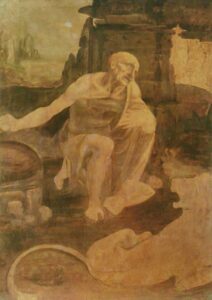
Saint Jerome in the Wilderness. Leonardo da Vinci c1480
by Anna Maria Benedetti in Milan

Before flying to the Metropolitan Museum in New York and then to the Louvre, the only painting by Leonardo in the Vatican collections or anywhere else in Rome was exhibited for three months in 2019 at the Braccio di Carlo Magno in St Peter’s Square. The image of San Gerolamo was painted on a walnut panel (103 × 74 cm) inside a beautiful gold frame from 1931 and was protected by an invisible climate-controlled display case. Admission to the exhibit was free. The painting has now been returned to the Vatican Museums.
San Girolamo (c347-419/20) was Father and Doctor of the Church. Disappointed by the ascetics of Aquileia and by the hermits of Chalcis, who were continuously in disagreement, he became profoundly depressed. It often happens in times of crisis that we somehow seem to find the answer to our problems, as expressed in the ancient Greek word krino, which means to judge: judgment presupposes reflection and from reflection comes the answer.
Leonardo also went through a difficult moment in his life in 1482: he found the right expression for his feelings in painting this picture, a subject that many workshops of the time were dealing with. It is his most tragic work. In his diary are the traces of his melancholy: “The greater the man, the more his ability to suffer grows”, or again in the annotation on the edge of a page of his Codex Atlanticus, “My Leonardo, why do you suffer so much?” (author’s translations.)
It is one of his most enigmatic paintings; there is no architecture, which is typically found in the paintings of his time. There are rocks in the background, those rocks that accompany the works recognized as by the artist, as in the Mona Lisa and The Virgin of the Rocks. There is no trace of a preparatory cardboard of the painting, though on closer inspection it appears Leonardo made changes right on the panel. While scrutinizing the work, we can see that the background was spread with the palm of his hand. Most curiously, the line that in Tuscany dominates painting of the time is attenuated with the ‘finger–painting’ technique. It gives the contours a poorly defined appearance, the gradient, for which the artist became famous. The presence or absence of the ‘finger’ or ‘hand’ technique is fundamental for the attribution of a work, as recognized by the artist’s fingerprints.
The contours are not well defined because we are uncertain; the rocks are in the background because in life there is always something hard to face and overcome. The choice of technique adapts to the representation.
Volume 34 no 6 July / August 2020


Thank you New Art Examiner for this review and all the other articles your magazine has given me here during these difficult months we have been living (call it living!). I find much solace in reading about the art world and in looking at paintings, though I have only the paintings from my small collection to look at. Perhaps it’s a way to evade reality, a reality which is getting less pretty by the day.
Aveline, Real art, the good stuff, is always a time out from life when it succeeds in doing only what art can do, what Greenberg called dancing three feet off the ground. Some depressing days I’m happy to just get one foot off.